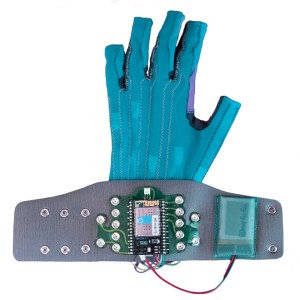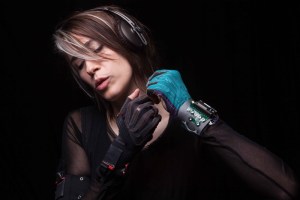Made in collaboration with British singer-songwriter Imogen Heap, the Mi.Mu glove turns the arms and hands of performers into musical instruments. Currently on Kickstarter, the project has raised about £67,000 (about $112,800) so far and has 16 days to reach its £200,000 ($336,620) goal.
Eventually, Heap and Mi.Mu’s developers hope the glove and its software, which will be made open source, will reach a wide range of users.
“Different musicians have different wishes in terms of connecting with the audience. For Imogen, her music that she creates in studio is very rich and layered and full of interesting sounds that she spent hours meticulously crafting and sampling,” says Kelly Snook, an engineer and musician on Mi.Mu’s eight-person development team.
“She found that it didn’t translate well in a performance, when she had to turn a knob or a fader or push a button. Her motivation was partly to get away from all the buttons and just gesturally do something in an intuitive way.”
Mi.Mu works by capturing movement and hand gestures with analog bend sensors. That information is then sent wirelessly via the x-OSC [a wireless input-output board] board on its wrists to a computer.

Software developed for Mi.Mu enables performers to map that data to musical control signals and combine different gestures and movements to make more complex controls. The gloves can also be programmed to control third-party music production and editing software.
Other people who have shown interest in Mi.Mu include an acrobatic DJ and an ice dancer.
“A lot of people are interested in the boundary between music and dance being blurred even further. A dancer becomes a musician, a musician becomes a dancer, that possibility is really interesting to some people,” says Snook.
Other use cases for Mi.Mu include potentially allowing virtual reality hardware makers to insert realistic hand movements into environments. It can also be used to recognize sign language. An early backer recently used the glove to trigger the Village People song “YMCA” with American Sign Language.
The first pair of Mi.Mu gloves were custom-made for Heap. Fingertips were left off so she could play the piano and program the gloves while wearing them. The palms are also open because Heap frequently claps her hands while looping.
Mi.Mu had to be wireless so she cold move around freely during shows and fit into Heap’s performance aesthetic. While working to bring the Mi.Mu glove toward production, its development team also had to figure out how to fit all of its components into a glove that could stretch enough to fit several hand sizes.
“There is a big constraint when you are producing a piece of tech, to be not obtrusive and attractive. [Heap] likes the techie look, which is fortunate because it’s hard to remove it completely,” says Snook. ” She wanted a little bit of the tech element, but also an elegance you don’t see in a lot of game controllers or bulky things.”

Before Mi.Mu’s Kickstarter campaign launched, the gloves had been funded and used primarily by Heap, but she “wanted this to be a universally accessible experience for people,” says Snook.
At £750 ($1,260) for a kit with the components to make a full glove, Mi.Mu is still fairly expensive, but development team hopes that anyone interested (including hacker groups and educational organizations) will get in touch with them through the Kickstarter page to find out ways to afford Mi.Mu or how they can contribute to its development.
Less pricey perks include a download or autographed CD copy of the first track written and performed by Imogen Heap with Mi.Mu. Supporters can also pledge 150 pounds for a glove without the electronic components or 200 pounds to attend a three-day workshop and learn how to make it.
“We are very, very interested in engaging the maker community. I think that there is a barrier because of the high cost for a lot of people and so we could like to encourage people to get in touch with us even if they aren’t able to pledge the levels,” says Adrian Lausch, a member of Mi.Mu’s team. “We want to reduce the barriers to getting involved.”
Right now the glove is about a “90% finished product” and is entering its final stage of development, says Lausch. As Mi.Mu moves toward completion, the team will work closely with collaborators who have pledged to receive a prototype of the gloves.
They will receive their pair by August and help the team finalize the design by the end of this year. Then the team hopes to send out all other glove pledges before Christmas.
People who pledge to receive a glove will get access to its software code before it is made open source in mid to late 2015.
“They will really influence what the final product looks like, but on the other hand, it will not look vastly different from what you see on the campaign. It will still have bend sensors, x-OSC, and LED lights. On the surface, the software will not change all that much but under the hood it will be much more advanced than at the moment,” says Lausch.
“Our Kickstarter campaign is to get to the point where we can manufacture at volume and at a much lower cost because that is our ultimate goal.”
To learn more about Mi.Mu, visit The Gloves Project or its Kickstarter page.